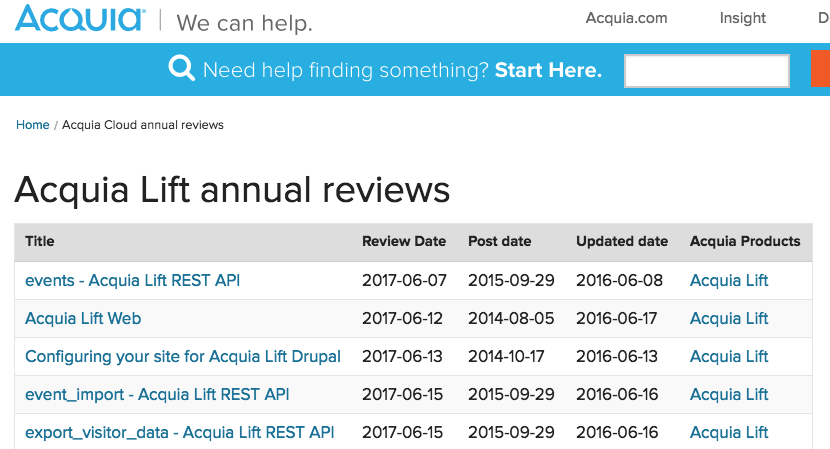
Building a Content Maintenance Strategy: Don’t be a Hoarder

Having a content management system in place for my website means that I don't have to worry about maintaining my content right?
Not exactly. When you get down to it, content maintenance is something that you need to actively plan for.
The CMS that you have in place is just a tool that allows you to input, create, format, and collaborate on content, and then delivers that to your website’s visitors with varying degrees of targeting and personalization. If content management is about developing and delivering content, then content maintenance begs the question: who manages and maintains your content?
How often do you refresh existing content? When do you know it is time to remove content from your website? When you do remove content, do you delete it or archive it?
These are all questions I’ve been asking myself lately.
More content is good. Right? Well, maybe. You want to make sure you’re writing and building content that adds value for your user and is accurate and helpful. I think we’ve all been there — spending a month working on a new landing page or a few months on a new website, launching it, and then sitting back and relaxing. But what will it look like in six months? Websites can quickly turn into the digital equivalent of an episode of Hoarders — and for some organizations, failure to weed their content libraries can cause reputational risk and confusion.
An online news site will usually hold onto all of their articles and other media — newspapers find a lot of value offering access, sometimes paid, to their “morgues.”
For many organizations, the failure to clean their content house can cause huge problems. Discontinued products that appear to still be in stock, expired promotions and landing sites that are forgotten and left to rot, comment threads on community sites that are left unmoderated... failure to be mindful about content will leave a bad impression about your brand.
Dumping scads of content into your site can confuse customers who may be new to your site and looking for some guidance as to what they should read “first” — this leads to the eternal “less-is-more” versus “more-is-more” debate.
I’m not here to tell you that I manage content on my websites well — I don’t! I’m here to tell you that I’m thinking about it these days, and you should too. This is the process I am going through right now:
Audit the content
To begin the process and ensure you’re starting with a clean house, do a content audit to determine what you have on your website. Create a spreadsheet that maps all the types of content that you currently have. When was the last time a discrete piece of content was updated? Does it get any traffic? This will give you a quick list of assets to purge from your website.
-
Tip: make sure to redirect those URLs to more relevant content, this is very important for search engines to drop old links and index new ones. If your CMS filters content by type (such as content type ie. blog, webinar, video), I recommend going through each item; if not, I recommend starting with your main navigation and then going through all pages linked off of it. Using a web analytics tool is also a helpful way to audit your content.
-
Image

Think about a plan and create a process
The document that you created during your audit can be used to understand what you have in place, what assets are performing, and which are old and in need of updating or retirement. After collecting a comprehensive view of your library of assets you need to set a process to review which ones are valuable, which are candidates for updating, and which need to be retired. This will entail notifying content “owners” and communicating your needs for either approval to archive or a request for the content author/sponsor to deliver an update to the original asset.
Update Frequency
Are there specific types of content that need to be updated more often that are time sensitive? Are there sections of content that are dated and therefore never need to be updated such as press releases? Part of this plan is creating a content edit/review calendar to communicate when content should next be reviewed, and by whom.
On Acquia.com, we try to update our product pages quarterly — this is because product information is very important to our users and the success of our business, and product information is often evolving. However, our customer case studies don’t need to be updated on a regular basis because the stories contained in them never change. Instead, case studies are reviewed less frequently for relevance and impact. Different content classes will have different timeframes and actions.
Decide who will manage updates
The answer to the question of “who?” depends greatly on how your organization is set up. Some organizations might have a dedicated team who manages all of their content including web, some will assign it out to sub groups within their department and manage it that way. There are many ways to do this, but making sure someone is responsible is key. You need to know that your content is being reviewed and maintained.
Communicate transparently
Use the CMS to allow communication between your content creators, reviewers, and editors. If you determine that you want to revisit a page based on a certain frequency, create a date field to contain the next review date, and then use Views to bring up this month’s list of content reviews.
Know that you need to retire a content item on a particular date? That’s just another date field, and another view. Finally, if you have the ability to use revisions for content nodes, use them and be descriptive when commenting on them, as they’ll help you keep track of changes that happen over time.

Why does this all matter?
Being mindful about your website’s content ensures your users will have a great experience and find the content they need to help make their decision or satisfy their needs— I have yet to meet a website visitor who likes to view stale or outdated content.
Keeping content updated will also make the search engines love your site, as search engines like Google can detect when content is refreshed and it helps add value to your relevance and page rank. Read my post on SEO optimization to learn more.
Frequently updating your website will ensure that your internal teams will keep using your website and sharing it with others — if anyone internally loses value and trust in your content, it will all be downhill from there and you’ll be dealing with the perpetual grumbling: “Our website sucks.”
The cleaner your content is, the easier it will be to maintain long term. Do yourself a favor and maintain it so you don’t have to spend months cleaning it up when the content board of health declares your site uninhabitable.
